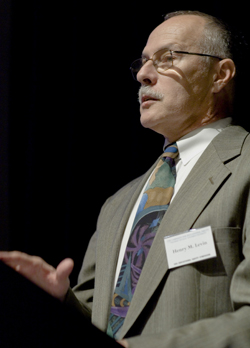More HS Grads = Big Taxpayer Savings
The U.S. taxpayer could reap $45 billion annually if the number of high school dropouts were cut in half, according to a new study led by Henry M. Levin, the College's William Heard Kilpatrick Professor Economics and Education.
The savings would be achieved via extra tax revenues, reduced costs of public health and crime, and decreased welfare payments. Even a one-fifth reduction would result in an annual $18 billion public savings, according to the study, whose figures do not even include the private benefits of improved economic well-being that would accrue to the new graduates themselves.
The study-'"titled "The Costs and Benefits of an Excellent Education for
"Educational investments to raise the high school graduation rate appear to be doubly beneficial," write Levin and his co-authors, Clive Belfield, Assistant Professor of Economics and Education at Queens College, City University of New York; Peter Muennig, M.D., Assistant Professor at Columbia University's Mailman School of Public Health; and Cecilia Rouse, Theodore A. Wells '29 Professor of Economics and Public Affairs at Princeton University. "The quest for greater equity for all young adults would also produce greater efficiency in the use of public resources."
Support for the study was provided to Teachers College by Lilo and Gerry Leeds.
To arrive at their estimates, the researchers calculated the public benefit generated by each intervention and subtracted the investment required to implement it. The $127,000 figure reflects the mean for both genders and all ethnic groups. The net public savings for each new graduate added among black males-'"the group most at risk for dropping out-'"is estimated at $186,500.
The new findings build on data presented-'"in October 2005 at a symposium held by TC's Campaign for Educational Equity-'"by the same team and other researchers that estimated that the
"What makes this study so powerful is that it has been conducted by economists of the first rank, using sophisticated approaches that, if anything, understate the potential value of investing up front in education," said former West Virginia Governor Bob Wise, who heads the Alliance for Excellent Education, based in Washington, D.C. "At a time when Congress is reevaluating the effectiveness of the federal No Child Left Behind Act, it provides lawmakers with a valuable tool to make the case that schools must be given more capacity to improve the achievement of their students."
The conservative approach used by the researchers does not include some of the benefits of graduation such as reductions in juvenile crime and teenage pregnancy that cannot be accurately quantified. In addition, national data tends to underestimate the numbers of high school dropouts, suggesting that the actual savings from increasing dropouts might be higher than those presented in the study. Among the study's other findings:
-' The average lifetime benefit in terms of additional taxes paid per expected high school graduate is $139,100.
-' The average lifetime public health savings per expected high school graduate (achieved through reduction in Medicare and Medicaid costs) is $40,500. For black females, the highest users of public health programs, the figure is $62,700.
-' The average lifetime crime-related cost reduction per expected high school graduate is $26,600.
-' Being a high school graduate is associated with a 40 percent lower probability of requiring Temporary Assistance for Needy Families (TANF); a 1 percent lower probability of receiving housing assistance; and a 19 percent lower probability of receiving food stamps. For college graduates, the probability reductions are 62 percent, 35 percent and 54 percent.
The five successful interventions on which Levin and his team based their calculations are:
-' Perry Preschool, the oft-chronicled pre--K program in
-' Class-size reduction. This approach-'"based on the parameters of Project Star, a four-year, randomized field trial in
-' First Things First, a comprehensive school reform of small learning communities that includes dedicated teachers, family advocates and instructional improvement. FTF would achieve an estimated benefit-to-cost ratio of 3.54 to 1 and create an additional 16 high school graduates per 100 students.
-' Chicago Child-Parent Center Program, a center-based preschool program with parental involvement, outreach and health/nutrition services, based in public schools. This approach would achieve an estimated benefit-to-cost ratio of 3.09 to 1 and create an additional 11 high school graduates per 100 students.
-' Teacher salary increase of 10 percent for all years K--12. This approach would achieve an estimated benefit-to-cost ratio of 2.55 to 1 and create an additional five high school graduates per 100 students.
In general, the study's authors identify several features that characterize effective school interventions: small-size schools; personalization; high academic expectations; strong counseling; parental engagement; extended time; and competent and appropriate personnel. They note that one of the interventions, First Things First, has the largest economic benefits relative to costs and combines all these features.
To view the full text of the study, visit www.cbcse.org, the Web site of the Center for Benefit-Cost Studies of Education, based at Teachers College. The Center conducts research on the benefits and costs of alternative educational policies and interventions. It brings together scholarship on both benefits and costs so that the full value of investments in education can be evaluated and the most productive use of resources can be chosen.
Published Friday, Feb. 23, 2007
